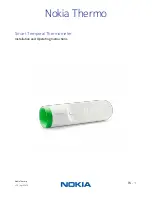
Basics of Infrared Thermometry
45
-
1-color sensors see polluted atmosphere and dirty windows and lenses as a reduction in energy
and give much lower than actual temperature readings.
Targets Smaller Than Field of View
When a target is not large enough to fill the field of view, or if the target is moving within the field of view,
radiated energies are equally reduced, but the ratio of the energies is unaffected and measured
temperatures remain accurate. This remains true as long as the background temperature is much lower than
the target temperature.
Example:
► Measuring of wire or rod — often too narrow for field of view or moving or vibrating unpredictably. It is
much easier to obtain accurate results because sighting is less critical with 2-color sensors.
Low or Changing Emissivity
If the emissivity in both wavelengths (colors) were the same, as they would be for any blackbody
(emissivity = 1.0) or greybody (emissivity < 1.0 but constant), then their ratio would be 1, and target
emissivity would not be an influence. However, in nature there is no such thing as a greybody. The emissivity
of all real objects changes with wavelength and temperature, at varying degrees, depending on the material.
When emissivity is uncertain or changing, a 2-color sensor can be more accurate than a 1-color instrument
as long as the emissivity changes by the same factor in both wavelength bands. Note, however, that
accurate measurement results are dependent on the application and the type of material being measured.
To determine how to use 2-color sensors with your application when uncertain or changing emissivity are a
factor, please contact your sales representative.












































